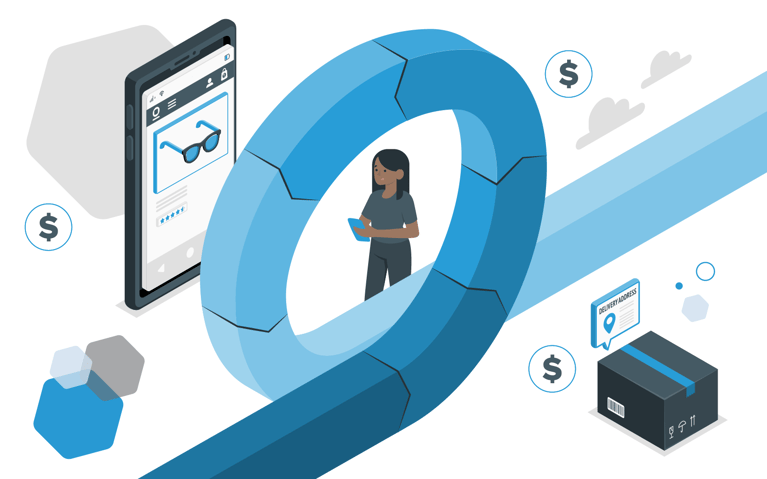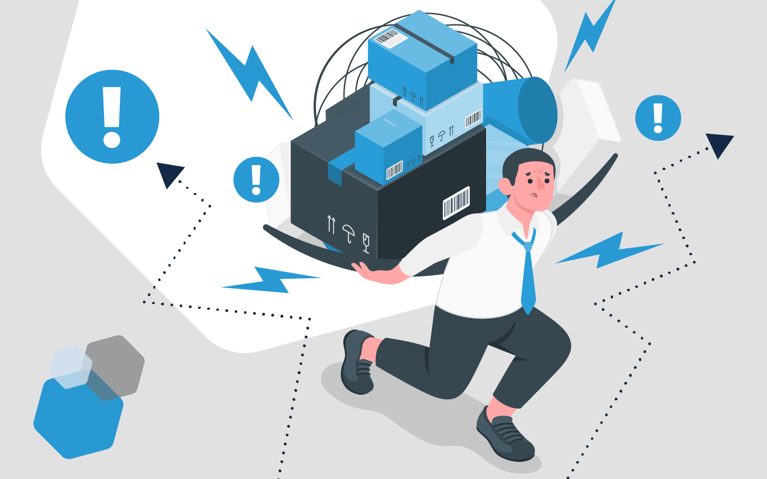Recommerce (or reverse commerce) is a swiftly growing market in the U.S. A recent report found that in 2023, 52% of consumers shopped secondhand apparel and 74% of retail executives who don’t currently offer resale are considering or planning to in the future. Consumers are drawn to recommerce because it aligns with their desire to make more eco-friendly choices, reducing waste and minimizing their carbon footprint. It also offers great value, allowing them to buy high-quality items at more affordable prices. Recommerce often features unique or vintage finds that add a special touch to their wardrobes or homes.
For brands, embracing recommerce signals a commitment to sustainability, which resonates with today’s conscientious shoppers. It opens new avenues for customer engagement through trade-in or buy-back programs, fostering loyalty and repeat business. Moreover, recommerce can boost a brand’s reputation, setting it apart in a competitive market by showing a genuine dedication to environmental and social responsibility.
Recommerce in the fashion landscape
Recommerce is the buying and selling of pre-owned goods. In the fashion industry, this spans anything from secondhand apparel and footwear to refurbished or upcycled items. Brands like Patagonia and The North Face have pioneered recommerce programs, offering customers a platform to trade in their used items for store credit or purchase secondhand items. This not only extends the lifecycle of products but also taps into a growing market of eco-conscious consumers who prioritize sustainability over fast fashion.
It's important to put the value of recommerce into perspective. According to recent statistics:
Up to 100 billion garments are produced by the fashion industry every year, and each year, as much as 92 million tons of clothing ends up in landfills.
- This is equivalent to the weight of over 15 million adult African elephants (assuming an average weight of 6 tons per elephant).
- It would be the same as filling around 1.7 million standard garbage trucks (assuming each truck holds about 54,000 pounds).
- In terms of volume, it's approximately the amount of waste that could fill the Empire State Building over 24 times (the building's volume is roughly 37 million cubic feet, and a ton of waste is about 2.5 cubic yards).
This immense volume highlights the significant environmental impact of the fashion industry and the importance of sustainable practices like recommerce to reduce waste. Furthermore,
- Only 20% of textiles are collected for reuse or recycling globally.
- In the US, 66% of all unwanted clothes and textiles are landfilled.
- Less than 15% are recycled.
- The rest (19%) are burned.
Recommerce benefits for consumers and brands
Recommerce significantly reduces waste by keeping products out of landfills and lowering the demand for new resources. By reselling or recycling items, brands contribute to a circular economy, promoting sustainability. For consumers, recommerce provides access to high-quality products at lower prices. Brands can attract cost-conscious shoppers and create additional revenue streams through resale. Recommerce programs can strengthen brand loyalty by offering value-added services such as trade-ins and buy-back programs. This engagement can foster a deeper connection with consumers who appreciate the brand's commitment to sustainability. An article by Harvard Business Review revealed that a brand’s sustainable practices were a core driver of consumer trust.
Assessing the recommerce feasibility for your brand
Before launching a recommerce program, assessing your brand's market position and understanding your consumer base is crucial. Analyze customer demographics and purchasing behaviors to determine if there is a demand for second-hand goods. Brands with a strong reputation for quality and durability, like REI, often find it easier to implement successful recommerce initiatives because their products retain value over time.
Not all products are ideal candidates for recommerce. Focus on categories where the items have a longer lifespan and can be easily refurbished or resold. For instance, high-quality footwear and durable outdoor apparel are often well-suited for recommerce due to their longevity and consistent demand.
Establish criteria for the condition and lifespan of products eligible for recommerce. Implement a thorough inspection process to ensure that only items meeting these standards are resold. This maintains the quality and reputation of your brand, ensuring customer satisfaction.
Developing a recommerce strategy
Like any strategy, recommerce requires clear goals and objectives. For example, your apparel or footwear brand should consider:
- Sustainability targets: Define your sustainability goals, such as reducing waste by a certain percentage or achieving a specific carbon footprint reduction. These targets will guide your recommerce strategy and demonstrate your brand's commitment to environmental responsibility.
- Revenue and profit goals: Determine the financial objectives for your recommerce program. This could include generating a specific amount of revenue from resale or achieving a particular profit margin.
- Customer satisfaction and retention: Aim to enhance customer satisfaction and retention through your recommerce program. Offer incentives like discounts or loyalty points to encourage participation and repeat business.
Once your goals are clear, you’ll want to:
Choose the right recommerce model
- Buy-back programs: Offer customers the option to sell their used items back to the brand for store credit or cash. This model has been successfully implemented by brands like Levi's.
- Trade-in programs: Allow customers to trade in old products for a discount on new purchases. Apple’s trade-in program for electronics is a notable example that could be adapted for fashion.
- Direct resale platforms: Create an online platform where customers can buy and sell pre-owned items directly. Brands like ThredUp and Poshmark have built successful businesses around this model. ThredUp lets businesses create stores as well. For example, brands like Madewell and Tom’s run their Madewell Forever and (re)WEAR GOOD recommerce stores through ThredUp’s platform.
Build your recommerce infrastructure
Efficient logistics and inventory management are critical to the success of a recommerce program. It requires a seamless apparel fulfillment and footwear fulfillment strategy with robust reverse logistics. Brands must develop a system to handle the collection, inspection, refurbishment and distribution of pre-owned items. This includes setting up dedicated warehouses and partnering with 3PL logistics providers experienced in handling secondhand goods.
Implement quality control processes
Quality control is essential to maintain customer trust and satisfaction. Establish rigorous inspection and refurbishment processes to ensure that all recommerce items meet your brand's quality standards. This might involve cleaning, repairing and reconditioning products before they are resold.
Develop a user-friendly online platform for recommerce transactions
Create or use an intuitive, user-friendly online platform where customers can easily buy and sell pre-owned items. The platform should feature clear product descriptions, high-quality images and a seamless checkout process. Patagonia’s Worn Wear program provides an excellent example of a well-designed recommerce website.
Market your recommerce program
Develop a strong narrative that emphasizes your brand's commitment to sustainability and the benefits of circular fashion. Share stories and testimonials from customers who have participated in your recommerce program, highlighting the positive environmental impact and personal satisfaction they’ve experienced. One brand that does this well is Eileen Fisher, a recommerce pioneer.
Use social media and email campaigns to promote your recommerce program and engage with your audience. Share tips on sustainable living, behind-the-scenes looks at your refurbishment process and user-generated content showcasing pre-owned items in use. Brands like Stella McCartney have effectively used social media to amplify their sustainability efforts. Encourage customers to participate in your recommerce program by offering incentives such as discounts, loyalty points, or exclusive access to limited-edition items. For example, Eileen Fisher’s Renew program rewards customers with store credit for returning their used clothing.
Integrate technology
Use technology to streamline product tracking and inventory management. Implement barcode or RFID systems to track items through every stage of the recommerce process, from collection to resale. This ensures transparency and efficiency, helping you manage inventory levels and reduce waste. Artificial intelligence (AI) and machine learning can enhance the customer experience by providing personalized product recommendations based on previous purchases and browsing behavior. This can increase sales and customer satisfaction, as shoppers are more likely to find items that match their preferences. Ensure that your recommerce platform has secure payment and transaction systems to protect customer information and build trust. Use encryption and secure payment gateways to safeguard financial data and consider offering multiple payment options to cater to different customer preferences.
Collaborate with partners
Collaborate with established third-party resale platforms like ThredUp or The RealReal to expand your recommerce reach. These platforms have existing customer bases and infrastructure, making it easier to scale your program quickly. When beneficial, partner with companies that specialize in recycling and refurbishing to handle the processing of pre-owned items. This can help you maintain high quality standards and ensure that non-resalable items are disposed of responsibly.
Engage with sustainability influencers and advocates to promote your recommerce program. These partnerships can help you reach a broader audience and build credibility within the sustainability community. Influencers like Lauren Singer, who runs the zero-waste blog Trash is for Tossers, can provide valuable exposure and endorsement.
Measuring and evaluating recommerce success
Once your recommerce program is up and running, you’ll want to track:
- Sales and revenue from recommerce: Monitor the financial performance of your recommerce program, tracking sales and revenue generated from pre-owned items.
- Customer participation rates: Measure how many customers are participating in your recommerce program, including the number of items traded in or purchased.
- Environmental impact metrics: Track the environmental benefits of your recommerce program, such as the amount of waste diverted from landfills and the reduction in carbon emissions.
- Gather customer feedback: Regularly gather customer feedback to identify areas for improvement in your recommerce program. Use surveys, reviews, and direct customer interactions to understand their experiences and make necessary adjustments to enhance satisfaction.
Based on initial results and feedback, scale your recommerce program by expanding product categories, increasing marketing efforts and optimizing logistics. Continuously monitor performance and make data-driven decisions to ensure long-term success.
Is recommerce right for your brand?
Recommerce programs offer significant benefits, including reduced environmental impact, new revenue streams and enhanced customer loyalty. By extending the lifecycle of products, brands contribute to a more sustainable fashion industry. Starting a recommerce program may seem daunting, but the positive impact on the environment and your brand's reputation makes it worthwhile. Take small steps, set achievable goals and continuously improve your processes to build a successful program.
The future of recommerce in the fashion industry looks promising as more consumers prioritize sustainability. By adopting recommerce, brands can lead the way in creating a circular economy, fostering a more sustainable and responsible industry for future generations. To learn more about how Cart.com supports brands with apparel fulfillment, footwear fulfillment and recommerce efforts, contact our logistics experts today.
Subscribe to our emails for the latest industry insights!
By entering your email, you agree to receive marketing emails from Cart.com




.png?width=1940&height=180&name=better%20software%20(1).png)


